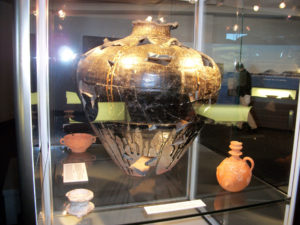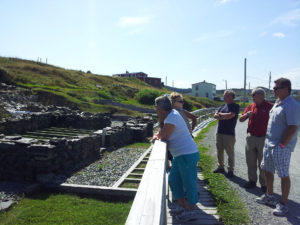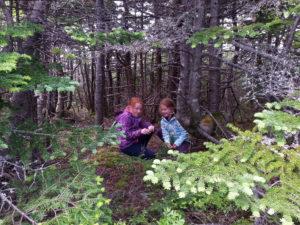My first visit to the ‘Colony of Avalon’ Interpretation Center at Baltimore’s Plantation in Ferryland, Newfoundland was a most confusing experience. While I had heard about George Calvert’s lavish expenditures and the painstaking attempts to establish every semblance of comfort for his family and those who would help him colonize 17th century Newfoundland – I was always of the impression that he never lasted a single winter and quickly moved on to a “more civilized climate in Baltimore, Maryland”.
Needless to say I was completely unprepared for such a display of wealth.
The first artifact you’ll note once you pass the foyer is an enormous Ming Vase that has been painstakingly restored – as best could be expected from the various shards recovered and “jig sawed” back into place by the expert archaeological team working the site. But it’s near complete and it’s magnificent. It’s actually a ‘Malta Jug’ though it would be the equal to a Ming in beauty, prestige and shipping costs. Who and how did anyone have the wherewithal for such luxury?
From there you begin to truly appreciate the archaeologist’s claim for a “100% find ratio” in every bucket of material sifted on the Ferryland site. There are a multitude of glass display cases and dozens of observation drawers containing 1000’s of items that one might expect to find in the most opulently appointed homes of 17th century England. Crystal glass stems, delicate china ware & porcelain pieces , gold coins, silver decanters, and a jeweled cross of prayer – you name it, it’s there.
At first I wondered what exactly they’d discovered. Were the Chinese here years before Lord Baltimore (Calvert’s knighted name) arrived? Did they stumble upon the hidden booty of an ancient pirate or privateer? Could Lord Baltimore have actually forwarded shiploads of his material possessions from England and then simply abandon them for a “stockade” in Maryland”? None of it made any sense until I started to notice that all of the artifacts carried their owner’s insignia – stamped to ward off thieves and / or, as a symbol of “monogramed” prestige.
But not a single item carried a “G.C.” as you might expect for George Calvert. Nor was there an “L.B.” for Lord Baltimore. No, every single item bears the mark of Lady Sarah Kirke – “S.K.”.
And then it all made sense.
First of all – This is not Baltimore’s study at all – the real story here is about Lady Sarah Kirke. Lady Sarah was the wife of Captain David Kirke who, having driven the French out of Canada in 1629, was later informed that a peace treaty was signed months before his successful rousting; “Yes, yes – great job chap but you see we signed this bloody agreement with the French – obviously you didn’t receive the memo but we’re simply obligated to give it back. Not to worry though for the King has agreed to sign over the rights to Newfoundland as compensation. A much better racket than chasing rodents across the countryside in Canada, you’ll have to agree. They’ve got fish, man. Millions of them. Fortunes to be made there for certain”.
Unfortunately Kirke soon found himself on the wrong side of England’s new monarchy and was thrown in the ‘Clink’ on his first trip home to England. Without a moment’s hesitation, Lady Sarah picked up the torch and went on to amass great fortunes in the salt fish trade, becoming the first successful woman entrepreneur in North American history.
Second – for all the stories ‘Random Passage’ and the ‘Shipping News’ would have you believe about Newfoundland’s perpetual state of impoverishment, there have been many fortunes generated on this island and the 17thcentury would have represented the wealthiest era in our history. It is said that Lady Sarah’s Ferryland plantation made as much money in a single season as was required to operate the entire British Navy in the same year. These artifacts are the niceties that she and her partners would have surrounded themselves with during their tenure – a period which lasted for nearly a century.
Finally, I am every bit as guilty as the next man when it comes to Newfoundland’s history and our need to compartmentalize time periods without any consideration for their overlap. When John Guy gave up on his dreams for Cupids (Newfoundland’s first colony) – the community didn’t simply vanish with his departure. So too did the folks from Sir William Vaughan’s colony in Trepassy, Calvert’s Ferryland, Carbonear, Harbour Grace and Bonavista. The original families stayed on, established their own operations and began future generations, who would also prosper, expand, and to this very day, call Newfoundland their home.





